How do I stop Starlings, Grackles and Blackbirds*?
These species can inundated many a backyard feeder. European Starlings (Sturnus vulgaris) are a non-native species and are not related to our native blackbirds. They are iridescent black with speckles. Their beaks are dark in winter and yellow in summer (shown below) .
Common Grackles (Quiscalus quiscula), who are black with a purple-blue sheen to their heads and black beaks, are our most common blackbirds. Red-winged Blackbirds (Agelaius phoeniceus) and Brown-headed Cowbirds (Molothrus ater) are other native blackbirds who may visit your feeders.
*While not technically correct, all three species are commonly lumped under the term "Blackbird," and for simplicity we will use the term throughout the article unless specific clarification needs to be made.

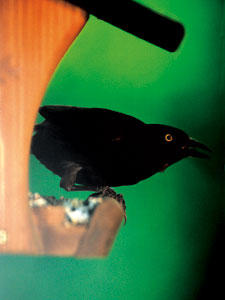
European Starlings' preferred diet consists primarily of insects and berries, but if these are hard to find, they turn to our feeders instead. Their beaks are not designed for cracking hard seed shells, so they go first for the softer suet cakes, peanuts, and other foods without shells. If those aren't available, they will even force themselves to eat hard shelled seeds. Fortunately, we do have a few tricks to eliminate Starlings from some feeders, and to slow them down at others, so your other birds can get their share of food, too. The other blackbirds are more traditional seed eaters. They are less likely to bother suet, unless it is of poor quality (i.e. filled with seeds or grains), but will devour most common seeds readily.
Here are our 3 Rules for Keeping out Starlings and Blackbirds
1. Offer Foods with Less Appeal: There are a few foods which are less palatable to blackbirds and using these in feeders that don't have guards on them can help discourage these birds from taking over.
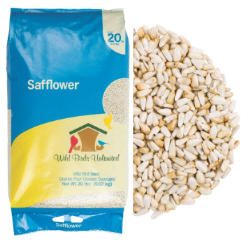 Safflower Seed: Sunflower-eating birds love Safflower; squirrels and blackbirds typically don’t. If you are looking to be more exclusive with your bird feeding, Safflower may be the solution for you. Many of your favorite birds will enjoy Safflower, yet blackbirds, grackles and squirrels typically don't. Safflower can be offered in hopper, platform or tube feeders, and it is especially helpful for window or deck feeders where blackbirds or squirrels may be a problem. Offer Safflower gradually, mixing it with the seed blends you currently provide, and over time, you'll end up with a dining spot for all kinds of birds, including House Finches, woodpeckers, nuthatches and chickadees.
Safflower Seed: Sunflower-eating birds love Safflower; squirrels and blackbirds typically don’t. If you are looking to be more exclusive with your bird feeding, Safflower may be the solution for you. Many of your favorite birds will enjoy Safflower, yet blackbirds, grackles and squirrels typically don't. Safflower can be offered in hopper, platform or tube feeders, and it is especially helpful for window or deck feeders where blackbirds or squirrels may be a problem. Offer Safflower gradually, mixing it with the seed blends you currently provide, and over time, you'll end up with a dining spot for all kinds of birds, including House Finches, woodpeckers, nuthatches and chickadees.
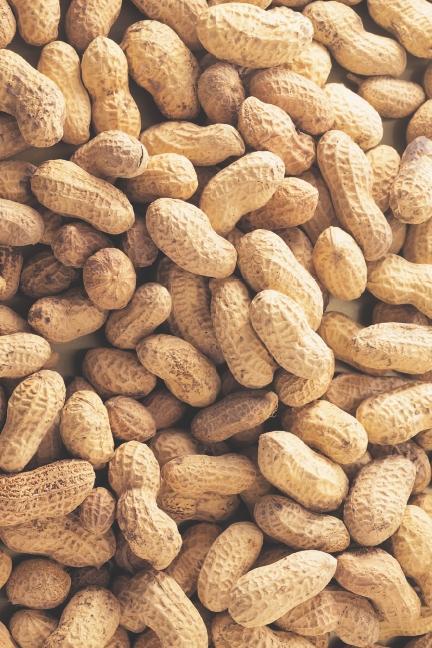 Peanuts in the Shell: Since European Starlings lack the beak strength to crack hard peanut shells, whole peanuts can successfully attract jays, woodpeckers, nuthatches and a few other species without encouraging starlings. About the only time we see starlings bother whole peanuts is if a woodpecker picks apart a shell and flies off with one peanut kernel, leaving the other kernel exposed, or if a batch of peanuts arrives with very thin or already cracked shells. Try peanuts in the shell in a number of interesting feeders. Peanuts are the best single source of protein and fat for your birds and a great addition to the choices you offer in your yard. We pride ourselves on being a one-stop bird feeding shop, not only offering bird feeders but also food to fill them. Peanuts in the shell are typically used for feeding squirrels and some of the larger billed birds such as jays. Titmice also enjoy peanuts in the shell. Use our peanuts in the shell in your peanut feeders to provide the energy that birds need.
Peanuts in the Shell: Since European Starlings lack the beak strength to crack hard peanut shells, whole peanuts can successfully attract jays, woodpeckers, nuthatches and a few other species without encouraging starlings. About the only time we see starlings bother whole peanuts is if a woodpecker picks apart a shell and flies off with one peanut kernel, leaving the other kernel exposed, or if a batch of peanuts arrives with very thin or already cracked shells. Try peanuts in the shell in a number of interesting feeders. Peanuts are the best single source of protein and fat for your birds and a great addition to the choices you offer in your yard. We pride ourselves on being a one-stop bird feeding shop, not only offering bird feeders but also food to fill them. Peanuts in the shell are typically used for feeding squirrels and some of the larger billed birds such as jays. Titmice also enjoy peanuts in the shell. Use our peanuts in the shell in your peanut feeders to provide the energy that birds need.
Grackles CAN crack peanut shells, so this advice applies only to starlings.
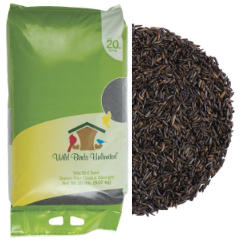 Nyjer® (Thistle) Seed: Nyjer® (thistle) is finches' favorite food. Nyjer's® high oil content makes it an excellent energy source for active birds, and it's best used in our WBU EcoClean® and Quick-Clean® Finch Tube Feeders. Since our WBU Finch Feeders have small holes for finch sized beaks access to the Nyjer® is near impossible for starlings and blackbirds; but the little birds such as American Goldfinches, House Finches, Purple Finches, Indigo Buntings, Pine Siskins, Redpolls and Black-capped Chickadees can access the food.
Nyjer® (Thistle) Seed: Nyjer® (thistle) is finches' favorite food. Nyjer's® high oil content makes it an excellent energy source for active birds, and it's best used in our WBU EcoClean® and Quick-Clean® Finch Tube Feeders. Since our WBU Finch Feeders have small holes for finch sized beaks access to the Nyjer® is near impossible for starlings and blackbirds; but the little birds such as American Goldfinches, House Finches, Purple Finches, Indigo Buntings, Pine Siskins, Redpolls and Black-capped Chickadees can access the food.
FEEDING TIP: Never offer bread, pizza crusts, or other similar foods. Few songbirds will eat them, yet these soft foods are extremely palatable to starlings and will act like a magnet, drawing every starling in the neighborhood.
2. Exclude Them! The most effective way to avoid losing all your bird food to starlings and blackbirds is to physically prevent them from gaining access to the food. These birds are simply too large to fit through the openings of the cages that surround the feeders below, yet smaller birds fly right through the openings in much the same way as they would fly through a fence or navigate in the dense branches of a bush. Even the larger woodpeckers can still feed thanks to their long necks, prying beaks, and agile tongues, which can stretch to obtain food. These cages will also stop squirrels and quickly pay for themselves in terms of food saved.
NOTE: Cages should have a diameter of 11” to avoid grackles and starlings eating the food by sticking their necks through the bars of the cage.
NOTE: Cages with 1½” mesh do not work to keep Red Squirrels or Eastern Chipmunks out. They can fit through the bars of the cage and are too light to trigger many squirrel proof bird feeders. Please see out section on Stopping Red Squirrels and Stopping Eastern Chipmunks if you have these visitors in your yard.
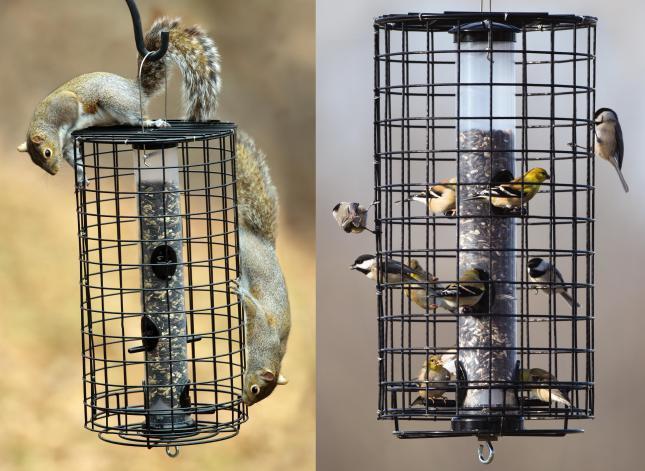 WBU Tube Feeder Cages: Add a WBU Tube Feeder Cage to our WBU Seed Tube Feeders, WBU Finch Feeders and WBU Peanut Feeders to protect the food from squirrels and larger birds. Cages feature a 1.5 inch by 1.5 inch mesh and are easy to install. Cages are available in two colors green and black. "On-Guard" Cages can fit over a variety of feeders and utilize 1½” openings which allow smaller birds to feed, but exclude European Starlings, Common Grackles and Eastern Gray Squirrels. These are perfect for deck rail feeding or for when the arrangement of trees in a yard won't allow the use of baffles.
WBU Tube Feeder Cages: Add a WBU Tube Feeder Cage to our WBU Seed Tube Feeders, WBU Finch Feeders and WBU Peanut Feeders to protect the food from squirrels and larger birds. Cages feature a 1.5 inch by 1.5 inch mesh and are easy to install. Cages are available in two colors green and black. "On-Guard" Cages can fit over a variety of feeders and utilize 1½” openings which allow smaller birds to feed, but exclude European Starlings, Common Grackles and Eastern Gray Squirrels. These are perfect for deck rail feeding or for when the arrangement of trees in a yard won't allow the use of baffles.
Cage Dimensions: 13” x 18” with a 13" Diameter
3. Slow Them Down: There are a few feeders and accessories worth mentioning that starlings and blackbirds can use, but which are challenging enough that the starlings and blackbirds may not completely dominate.
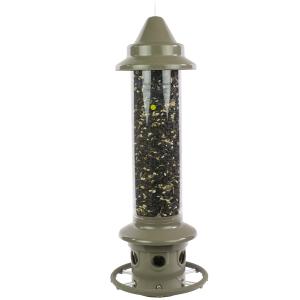 WBU Eliminator: Protect your bird seed bounty from squirrels with our WBU Eliminator bird feeder. When a squirrel touches the perch ring, its weight closes the seed ports, foiling its seed-stealing plot. The WBU Eliminator's unique technology allows you to set the sensitivity level, so you can also exclude large birds such as pigeons or doves. The tension setting can also be used to keep out the lighter Red Squirrel. This feeder can be hung or pole mounted using the WBU Eliminator Squirrel Proof Bird Feeder Pole Adapter Assembly Kit (sold separately- see description below). The WBU Eliminator Squirrel Proof Bird Feeder Pole Adapter Assembly Kit (sold separately) allows the Eliminator to be mounted on a WBU Advanced Pole System® (APS) (sold separately). The WBU Eliminator has a capacity for approximately 3 lbs. (1.36 kg) or 14 cups of seed. The WBU Eliminator weighs approximately 3.2 lbs. (1.45 kg) unfilled and 6.2 lbs. filled (2.81 kg). If a tree were to hold this feeder, it would have to be a very sturdy tree. This feeder also features a special seed ventilation system that helps keep seed fresher. The WBU Eliminator can be disassembled and assembled with no tools, and all of its parts are top shelf dishwasher safe. The WBU Eliminator is available in gray or green. This feeder is backed by a limited lifetime guarantee.
WBU Eliminator: Protect your bird seed bounty from squirrels with our WBU Eliminator bird feeder. When a squirrel touches the perch ring, its weight closes the seed ports, foiling its seed-stealing plot. The WBU Eliminator's unique technology allows you to set the sensitivity level, so you can also exclude large birds such as pigeons or doves. The tension setting can also be used to keep out the lighter Red Squirrel. This feeder can be hung or pole mounted using the WBU Eliminator Squirrel Proof Bird Feeder Pole Adapter Assembly Kit (sold separately- see description below). The WBU Eliminator Squirrel Proof Bird Feeder Pole Adapter Assembly Kit (sold separately) allows the Eliminator to be mounted on a WBU Advanced Pole System® (APS) (sold separately). The WBU Eliminator has a capacity for approximately 3 lbs. (1.36 kg) or 14 cups of seed. The WBU Eliminator weighs approximately 3.2 lbs. (1.45 kg) unfilled and 6.2 lbs. filled (2.81 kg). If a tree were to hold this feeder, it would have to be a very sturdy tree. This feeder also features a special seed ventilation system that helps keep seed fresher. The WBU Eliminator can be disassembled and assembled with no tools, and all of its parts are top shelf dishwasher safe. The WBU Eliminator is available in gray or green. This feeder is backed by a limited lifetime guarantee.
Dimensions Feeder: 28½" x 8" Diameter
Dimensions Tube: 21¼" x 4½" Diameter
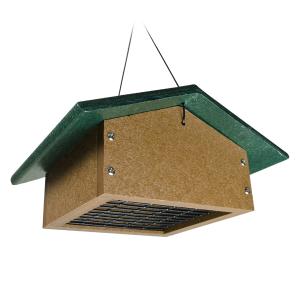 WBU EcoTough® Upside Down Suet Feeder: There are quite a few books and magazines that claim Starlings can't hang up-side down like the woodpeckers. Well, the starlings didn't read those articles and we'll be the first to say the WBU EcoTough® Upside Down Suet Feeder is not foolproof. However, the challenge of accessing food from only the bottom of this feeder may be enough to keep starlings from eating an entire suet cake in one sitting. So, if you don't care for the look of the cage style protectors above, this feeder may be helpful.
WBU EcoTough® Upside Down Suet Feeder: There are quite a few books and magazines that claim Starlings can't hang up-side down like the woodpeckers. Well, the starlings didn't read those articles and we'll be the first to say the WBU EcoTough® Upside Down Suet Feeder is not foolproof. However, the challenge of accessing food from only the bottom of this feeder may be enough to keep starlings from eating an entire suet cake in one sitting. So, if you don't care for the look of the cage style protectors above, this feeder may be helpful.
Dimensions: 10½” x 8” x 9”


